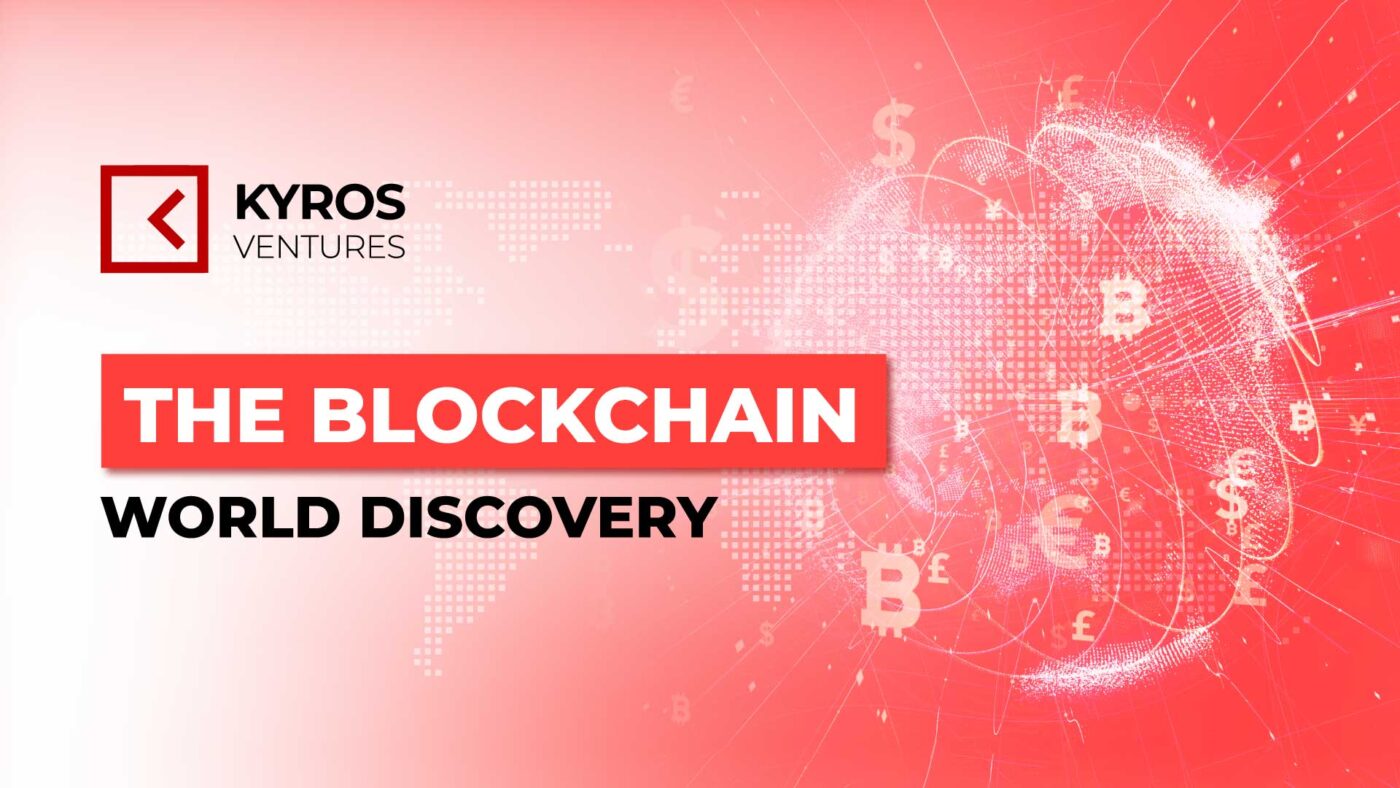21st century. 2008.
A cataclysm called the “Global Financial crisis” swept through the globe, leaving a massive shock for the entire financial markets, especially the banking and real estate industry. The crisis then eroded people’s trust in a centralized and bureaucratic financial system with plenty of vulnerabilities.
From this erosion of trust, there came the invention of the blockchain, marking the beginning of a new era in the technological revolution.
In this world, each blockchain platform is seen as an independent country where the gas fees are their living costs and their consensus mechanism is regarded as a type of political philosophy.
This blog post does not intend to wireframe your point of view into any specific countries or political organizations in the real world. We hope the audience can take an open view with these disclaimers in mind and enjoy the comparisons provided here. Thank you.

The Paleozoic Era: Bitcoin
Blockchain was first termed in 1991 by the two scientists Stuart Haber and Scott Stornetta in the article “How to timestamp a document digitally”.
It was until 2008 that blockchain was popularized when one of its first major applications, Bitcoin, a peer-to-peer electronic cash system, was introduced to the world by a person named Satoshi Nakamoto. The purpose of Bitcoin is to solve the double-spending problem without the need for a trusted authority or any centralized entities.
Bitcoin has always dominated in terms of the very first cryptocurrency built on blockchain thanks to its decentralised consensus. The recent expansion of Bitcoin and blockchain has led legislators and investors in the traditional financial world to see them as a threat to the country’s staunch anti-money laundering system. But at the same time, they also consider this a potential ground for new investment opportunities and break out of the old-fashioned investment channels whose profits are already saturated.
While Bitcoin is the most powerful country in the blockchain world, it is still not an ideal location for creating economic activities for society. One of Bitcoin’s most important legacies is its political philosophy – Proof-of-Work. Other countries, such as RSK, DefiChain or Stacks, have contributed to bringing new vitality to Bitcoin by allowing its users to participate in activities in their own country while still securing them through a direct connection to Bitcoin.
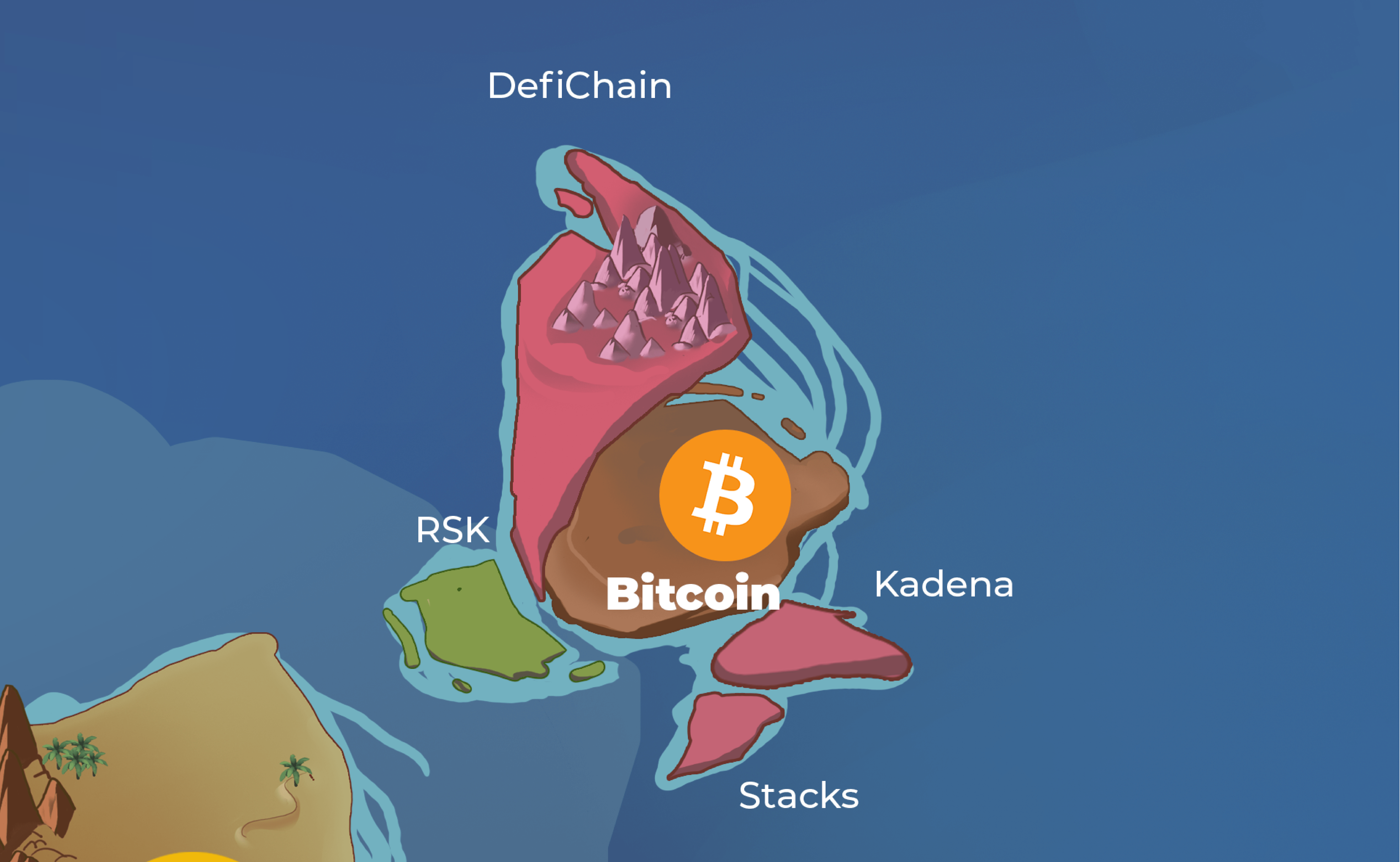
EVM Union: Where Civilization Begins
Although Bitcoin has a big influence on the blockchain world, Ethereum takes the lead in terms of prosperity. Ethereum, founded by Vitalik Buterin in 2013, created a new political philosophy called Proof-of-Stake with its administrative apparatus, called the Ethereum Virtual Machine (EVM). Many countries that came out later used this administrative apparatus, thereby forming the EVM Union.
The purpose of EVM is to serve as a runtime environment for smart contracts built on Ethereum which is a new way to build decentralized applications.
Another reality that plays out on Ethereum is that although the country leads in prosperity, it also leads in terms of the living costs. The fees that users need to pay when building and living on Ethereum range from $5 to $100 depending on different activities (not to mention peak hours), much higher than in other countries. The high standard of living comes from so many activities happening there where resources and land only exist as a limited amount.
As a result, the products on Ethereum (i.e., the blockspace) experienced a severe imbalance between supply and demand. To solve this problem, many other blockchains have been built around Ethereum to reduce the crowded activities on the land. These countries are categorized based on the infrastructure they use to offload activities on Ethereum, including each of the following subgroups:
- Optimistic Rollup: This is where transactions are bundled together (to save space and costs) and are validated by default. The system will have a reward mechanism for those who can prove that these frauds are genuine. Nations of this group are Arbitrum, Optimism, Boba Network, and Metis.
- ZK Rollup: This scalability solution works almost similarly to Optimistic Rollup, but cryptographic proofs are used to prevent frauds more proactively. Starkware, zkSync, and Immutable X belong to this group.
- State channels: First transaction is settled on the chain, opening up a new channel so that in-between transactions are settled off-chain and secured by a multi-sig system; then, when the interaction between two parties ends, the last transaction will be settled on the chain. Connext, Perun, Raiden, and State Channels are members of this group.
- Sidechain: These countries have their own political philosophy, running in parallel and connected to Ethereum through a bridge. Countries under this category are Polygon, Palm, Ronin, and Gnosis Chain.
- Plasma: Countries in this group may have their own political philosophy but derive security from Ethereum through fraud proofs. They are different from sidechain in the sense that everytime they finish sanctioning a resolution, they will submit this sanction to the Ethereum mainnet. OMG Network belongs to this group.
- Validium: Validium countries like StarkEx or zkPorter secure transactions that take place in their countries through cryptographic proof with the computation data being stored off-chain.
BNB Chain
Despite being built on forks of Tendermint and Cosmos SDK, BNB Chain belongs to the EVM Union. This explains why the BNB Chain is placed inside the EVM Union and next to the Cosmos continent.
Being backed by the largest crypto exchange in the world, Binance, it is no surprise that this nation stands in the top 2 of TVL with multiple high-quality projects. Besides, it is a country of GameFi projects. This place has all it needs for a GameFi project to take off:
- A vibrant community
- A secure and liquid NFT marketplace
- Cheap cost and fast transaction for users
- Huge support from the Binance team itself
BNB Chain follows the Proof-of-Authority and Delegated Proof-of-Stake (Delegated Proof-of-Stake) philosophy to help its operations run smoothly while maintaining a reasonable living cost.
Avalanche
Another Chad in the EVM Union is Avalanche. Only launched in 2020, this country has quickly risen to be the third-largest in the Union. The superb design in its political philosophy plays a vital role in bringing Avalanche to this position when it has attracted plenty of human and financial capital resources. Avalanche also aims to be a sovereign country with multiple subnets being built around it. The first two countries in this sovereignty are Defi Kingdoms, a well-known game title originating from Harmony but still in this EVM Union. The other is Swimmer Network, born from the most played game on Avalanche Crabada.
Avalanche does have its own Executive Branch – Avalanche Virtual Machine. X-Chain, the chain which is in charge of asset creation and exchange, is an instance of AVM.
Fantom
Starting with an idea of modular architecture, Fantom is a country that makes it easy for immigrants to live, integrate and adapt to the lifestyle here. It has attracted a lot of migrants and enriched its land, and is now ranked fourth in the EVM Union.
Nevertheless, Fantom encountered a crisis earlier in 2022 stemming from the demise of Solidex, a project that was running on Fantom at the time, and the departure of Andre Cronje, the person behind the formation of Fantom. Most recently, a lending institution in this nation, Deus Finance, was attacked by hackers, leading to the degradation of life quality and severe brain drain as users migrated to new and safer lands.

Polkadot: The rise of multi-chain
Ethereum and Vitalik Buterin’s Smart Contracts have revolutionized the blockchain world, but that doesn’t seem to be enough to keep Gavin Wood, once a co-founder of Ethereum, staying and contributing to Ethereum. In 2016, Gavin Wood left for a new adventure to conquer new lands that can pursue the “decentralization” mandate of blockchain.
That is how Polkadot was formed.
Unlike Ethereum, where all vitality and activities take place on a single platform, Polkadot allows the birth of many satellite countries to exist in parallel as an extension country, thereby reducing the workload pressure that Polkadot has to handle. Relay-chain is at the heart of Polkadot. All activities are coordinated through a relay-chain with many para-chains, which are satellite countries, surrounding this centre to exchange and receive security from the force of validators gathered here. Currently, a total of 14 countries exist on this Polkadot continent. Each country pursues a different goal to achieve the final objective of diversifying the continent’s ecosystem: Efinity focuses on infrastructure for NFTs; Astar, Phala Network, Clover or Moonbeam focuses on infrastructure for Smart Contracts; Nodle focuses on blockchain infrastructure for IoT (Internet of Things) technology; Statemint serves the deployment of digital assets on the Polkadot network; while HydraDX, Interlay, Cetrifuge, Composable Finance, Parallel, Equilibrium and Acala focus on DeFi.
Kusama is a strip of a continent connected to Polkadot. Therefore, this continent is built for users to have a creative environment and test their ideas before officially deploying on Polkadot. Although often being seen as a “simulation” environment of Polkadot, Kusama still has its own habitat for people to participate in the construction and a separate economic system that everyone must follow while living here. Currently, 29 countries exist in this territory.

Cosmos: A universe of blockchains coming to reality?
Regarding a scalability solution for Ethereum, Polkadot or Avalanche is not the first country to introduce the concept of multi-blockchain on a territory; Cosmos has previously thought of it.
Jae Kwon first explored this continent, with the Tendermint BFT algorithm being the first seed. And from there, a Cosmos SDK development framework was formed, allowing programmers to build separate blockchains called Zones. Zones are directly connected to the Hub, the central blockchain of Cosmos, operating as a Proof-of-Stake institution. These blockchains will communicate with each other using the Inter-blockchain Communication (IBC) protocol; however, it should be noted that only blockchains with deterministic finality can use this protocol.
Some well-known countries on the Cosmos continent include Terra, Cronos, Osmosis, Evmos, or THORChain.
It is worth noting that Terra was once one of the most prosperous countries on the Cosmos continent. Terra’s native currency $LUNA has been rising continuously despite the current gloom of the blockchain world. Nonetheless, this empire collapsed within a short period, mainly due to a loophole within its framework that allows for printing the $UST stablecoin from $LUNA, leading to a death spiral when $UST was no longer pegged at $1. The Terra founding team and the community recently passed a vote to revive this country with a new domestic currency $LUNA, convert the old currency into $LUNC (Terra Classic), and $UST will forever disappear in this new sovereignty.
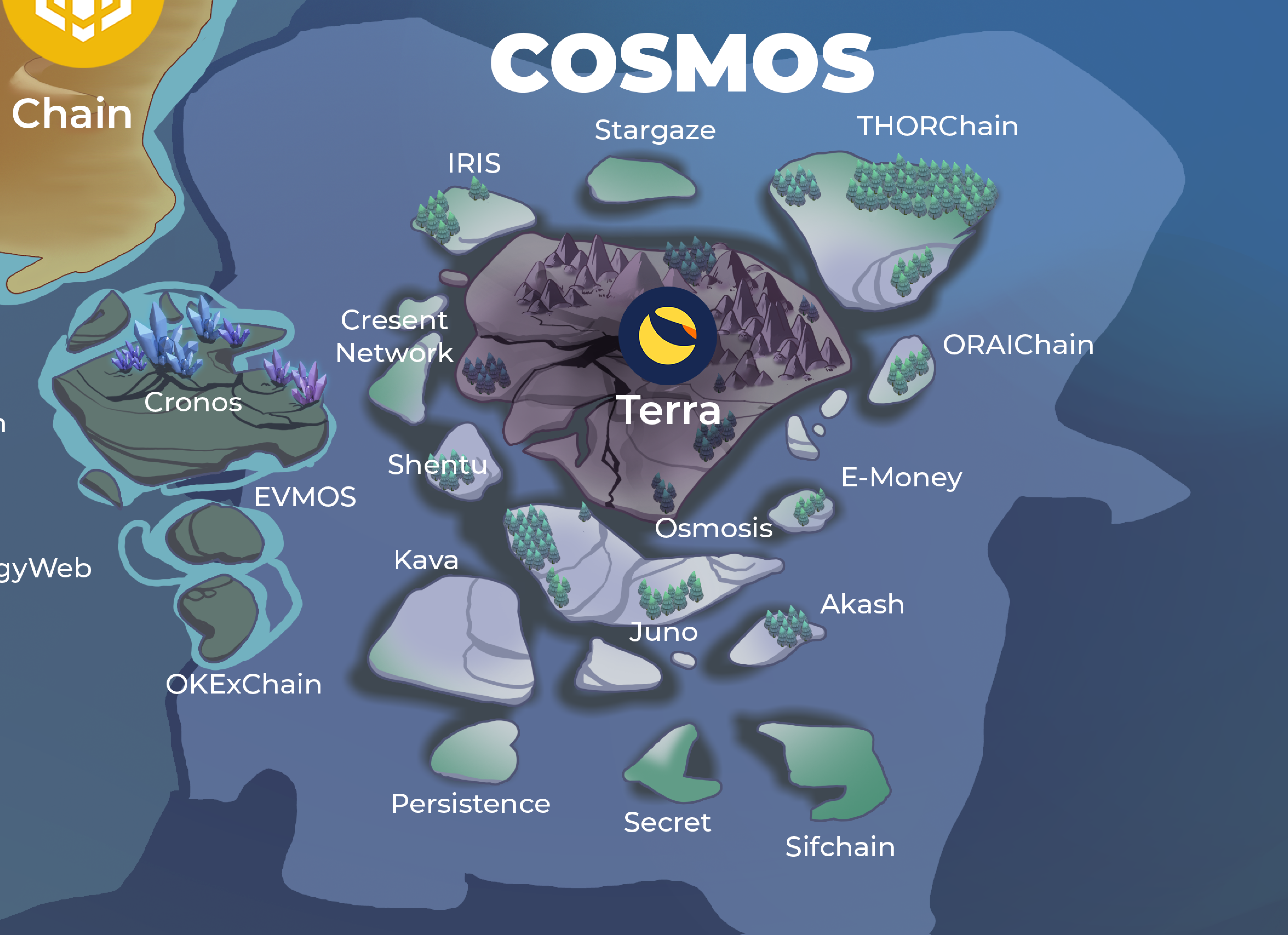
Other countries
Besides these vast swathes of land, some islands are separate and not part of any Union or Commonwealth, such as Tron and Solana.
Solana
Solana is building its own empire with the current objective of being a new promising land for games and NFTs. Their strengths lie in the non-bureaucratic system, the ability to finalize transactions within milliseconds, thanks to Proof-of-History mechanism, which allows the validators to record the sequences of transactions on the network. Nevertheless, such quickness and ease-of-use in its system is a double-edged sword: there are computational bots that are designed to keep spamming the network, therefore creating unnecessary congestion or even causing a network outage, which negatively affects other citizens. In the newest proposal, the Solana team is planning to implement stake-weighting in validating transactions to mitigate this issue.
It should be noted that Solana does establish an endeavour to partner with other unions through other blockchains such as Velas, or through a smart contract such as the NEVM of Neon Labs.
TRON
Tron was founded in 2017 but appeared to be left behind compared to other nations. In June 2018, Tron declared its Independence Day and was independent from its Genesis Block. In October 2018, it established its own political philosophy, the TRON virtual machine, with a complete toolset for developers. However, because of the fixed fee of 1 USDT when transferring USDT via TRON, this country is still alive, with about 35 billion $USDT circulating in this country, even higher than the wealthiest country – Ethereum.
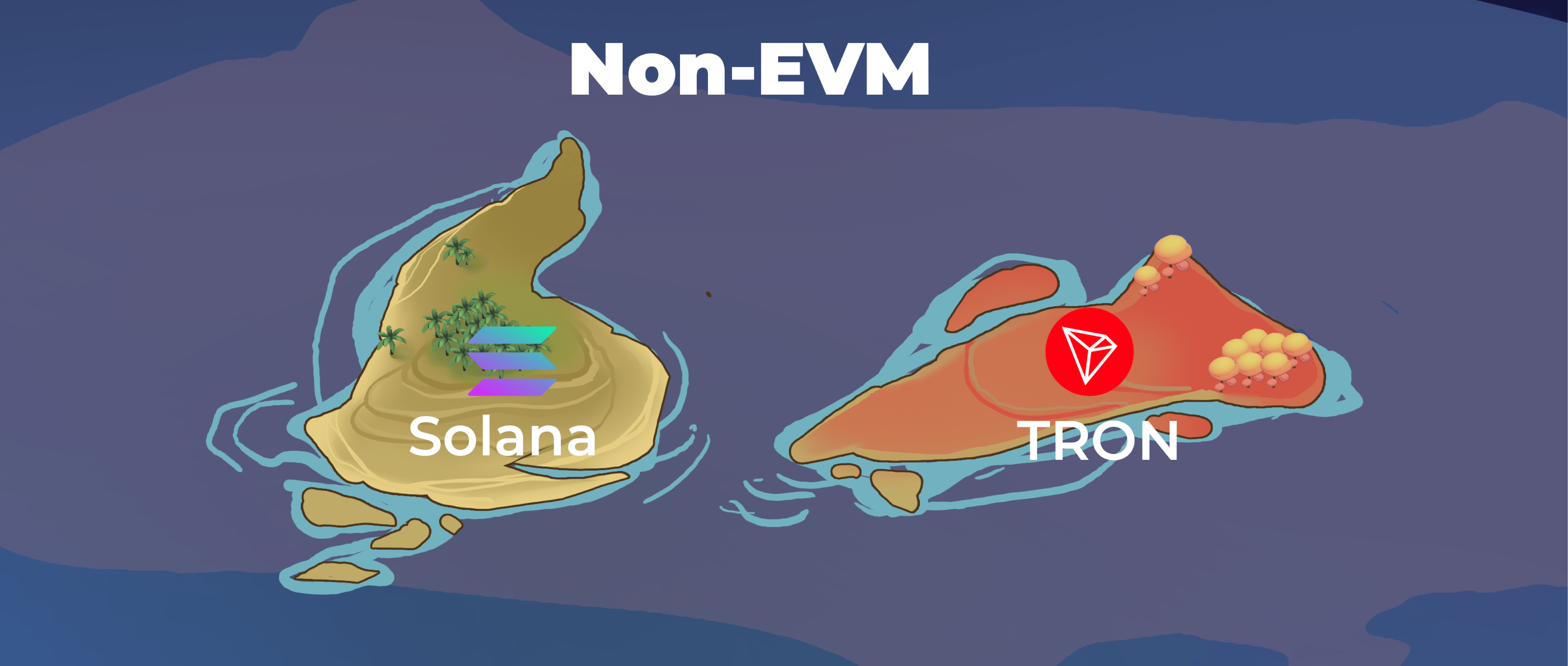
The most popular language: Rust
Solidity, the primary language of Ethereum, is considered the most popular language among blockchain programmers. Many blockchain platforms built later on have also used Solidity to integrate EVM and join the EVM Union to attract human resources and financial capital from this country more efficiently. However, the new concept of multi-blockchain proposed by Polkadot or Cosmos and the rise of blockchain platforms like Solana have also fueled the popularity of Rust and Golang, the two main languages spoken on those continents. Rust is now the most commonly used programming language in the blockchain world.
What’s next?
After 14 years of establishment, the blockchain world has been divided into several continents and countries with independent political philosophies or development paths. The concepts of Smart Contracts and Proof-of-Stake have unlocked up a new period of promoting economic activities and thus being applied by most countries in the blockchain world.
Besides, multi-chain activities are essential for a globalized future, promoting immigration and trade among users. But at the same time, individual blockchain nations must ensure the facets of security for their people. EVM, Polkadot and Cosmos are all potential continents towards globalization. In addition, many new initiatives will be launched to further enrich these ecosystems, thereby strengthening the overall development of the blockchain world.
